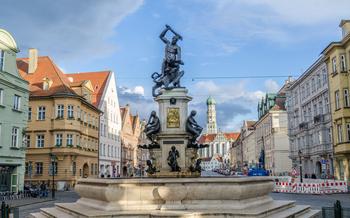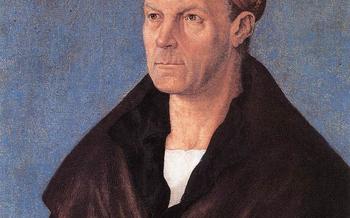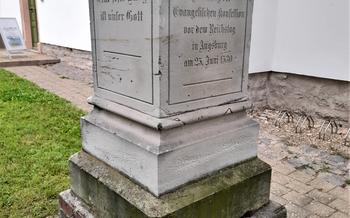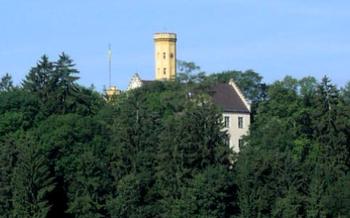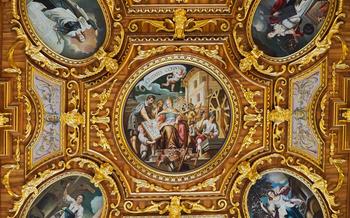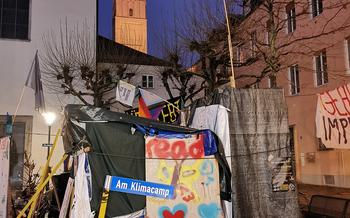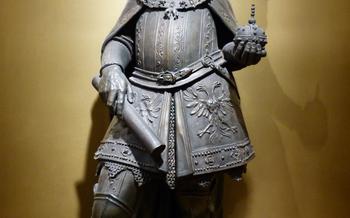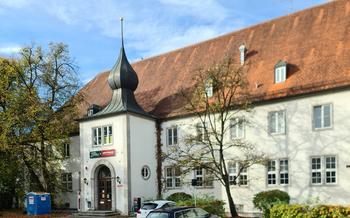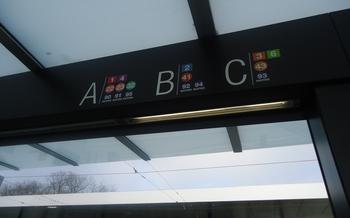
Augsburger Rathausplatz
- Rathaus: The Epitome of Renaissance Grandeur
- Perlachturm: A Tower with a Rich Past
- St. Peter am Perlach: A Historic Church with Gothic Charm
- Herkulesbrunnen: A Fountain of Mythical Proportions
- Fuggerhäuser: A Legacy of Wealth and Power
- Schaezlerpalais: A Palace of Art and History
- Augsburg Cathedral: A Masterpiece of Gothic Architecture
- Maximilianstrasse: A Grand Boulevard with Historic Charm
- Wittelsbach Park: A Tranquil Oasis in the City
- Augsburg Zoo: A Home for Diverse Wildlife
- Augsburg Puppenkiste: A World of Marionettes
- Augsburg City Museum: A Journey Through History
- Insider Tip: Exploring Augsburg's Hidden Gems
Rathaus: The Epitome of Renaissance Grandeur
The Rathaus, or Town Hall, stands as a testament to Augsburg's wealth and power during the Renaissance era. Its construction began in 1615 under the direction of Elias Holl, a renowned architect of the time. The Rathaus boasts an impressive blend of Renaissance and Baroque architectural styles, showcasing intricate carvings, ornate gables, and a magnificent clock tower that dominates the skyline.
The Golden Hall, located on the second floor of the Rathaus, is the building's crowning glory. This opulent hall served as a gathering place for the city's council and was lavishly decorated with gold leaf, frescoes, and intricate stucco work. The ceiling features stunning paintings depicting scenes from Augsburg's history, while the walls are adorned with portraits of the city's prominent figures.
Guided tours of the Rathaus are available, allowing visitors to explore the building's grand interior and learn about its fascinating history. The Rathaus is also a popular venue for weddings and other special events, adding to its allure as a symbol of Augsburg's civic pride and heritage.
Perlachturm: A Tower with a Rich Past
Augsburg's Perlachturm is a captivating blend of architectural elegance and historical significance. Its roots can be traced back to the 10th century, when it served as a watchtower as part of the city's fortifications. As Augsburg grew and evolved, the tower underwent several modifications and extensions. The most notable addition was the onion-shaped dome, constructed in the 16th century, which lends the tower its distinctive silhouette.
The Perlachturm stands tall at 70 meters, offering visitors a chance to ascend its 258 steps to reach the observation deck. From this vantage point, one can enjoy breathtaking panoramic views of Augsburg's cityscape, including the majestic Rathaus, the spires of St. Peter am Perlach, and the greenery of Wittelsbach Park.
Beyond its architectural charm, the Perlachturm holds a profound cultural significance. Historically, it served as a symbol of the city's independence and autonomy. Its bell, known as the "Bürgerglocke" (Citizen's Bell), was rung to announce important events and gatherings. Today, the Perlachturm remains a beloved landmark, deeply embedded in the hearts of Augsburg's residents.
Guided tours of the tower are available, providing visitors with insights into its fascinating history and architectural features. It's an experience that unveils the rich tapestry of Augsburg's past and offers a unique perspective on this vibrant city.
St. Peter am Perlach: A Historic Church with Gothic Charm
Amidst the bustling streets of Augsburg, stands the historic church of St. Peter am Perlach, a testament to the city's rich Gothic heritage. Built between the 11th and 15th centuries, this magnificent edifice boasts an impressive blend of Romanesque and Gothic architectural elements. The church's towering steeple, reaching towards the heavens, dominates the skyline and serves as a beacon for the faithful.
The interior of St. Peter am Perlach is a treasure trove of Gothic art and architecture. Vaulted ceilings soar overhead, supported by slender pillars, creating a sense of awe and grandeur. The intricate stained glass windows, depicting scenes from the Bible and the lives of saints, cast a kaleidoscope of colors onto the stone floors below. The church's medieval altarpieces, carved with meticulous detail, showcase the artistry and craftsmanship of a bygone era.
Don't miss the opportunity to climb the 258 steps to the observation deck of the Perlachturm, the church's iconic tower. From this vantage point, you'll be rewarded with breathtaking panoramic views of Augsburg's rooftops, the surrounding countryside, and the distant Alps.
Whether you're a history buff, an architecture enthusiast, or simply seeking a moment of tranquility, St. Peter am Perlach is a must-visit destination in Augsburg. Guided tours are available to provide insights into the church's fascinating history and architectural significance.
Herkulesbrunnen: A Fountain of Mythical Proportions
At the heart of the Rathausplatz, the Herkulesbrunnen (Hercules Fountain) stands as an emblem of power and strength. This monumental fountain, built in 1597, pays homage to the legendary hero Hercules and his unbeatable might.
The centerpiece of the fountain is an impressive bronze statue of Hercules, battling the fearsome many-headed Hydra. The intricate details and expressive musculature of the statue capture the essence of Hercules' heroic struggle. Water cascades dramatically from the fountain's tiers, creating a mesmerizing visual and auditory display.
The Herkulesbrunnen is a testament to the artistic prowess of the Renaissance period. Its design symbolizes the triumph of good over evil, resonating with the spirit of the Reformation that Augsburg embraced. The fountain's allegorical significance adds depth to its aesthetic beauty, making it a cultural and historical landmark.
Whether you admire its intricate details up close or marvel at its grandeur from afar, the Herkulesbrunnen is a must-see for any visitor to Augsburg. Its enduring presence and timeless symbolism make it one of the city's most iconic landmarks.
Fuggerhäuser: A Legacy of Wealth and Power
The Fuggerhäuser, a complex of buildings in the heart of Augsburg, stands as a testament to the immense wealth and power of the Fugger family, one of the most influential merchant families in Europe during the Renaissance period. Constructed in the 16th century, these buildings showcase a blend of Gothic and Renaissance architectural styles, reflecting the Fuggers' rise to prominence as financiers and traders.
The Fuggerhäuser complex comprises several interconnected buildings, each serving a specific purpose. The most prominent among them is the Fuggerei, a courtyard complex built in 1521 as a charitable housing development for the city's poor. The Fuggerei, still inhabited today, is considered the oldest social housing project in the world and offers a glimpse into the philanthropic endeavors of the Fugger family.
Other buildings within the Fuggerhäuser complex include the Fuggerhaus, which served as the family's residence and is now a museum showcasing their history and achievements. The Jakoberhaus, another residential building, is adorned with intricate frescoes and paintings that depict scenes from the Fuggers' lives.
The Fuggerhäuser, with their impressive architecture and historical significance, are a must-visit for anyone interested in the history of Augsburg and the rise of the Fugger family. Guided tours of the complex are available, providing insights into the lives and legacy of these influential merchants.
Schaezlerpalais: A Palace of Art and History
Augsburg's cultural heritage extends beyond its historic churches and squares to include the magnificent Schaezlerpalais. Built in the 18th century as a residence for the wealthy Schaezler family, this opulent palace now houses the State Art Collection, a treasure trove of artistic masterpieces.
The Schaezlerpalais is an architectural marvel, showcasing a blend of Baroque and Rococo styles. Its grand facade, adorned with intricate carvings and sculptures, hints at the opulence that awaits inside. The interior is equally impressive, with spacious halls, elegant staterooms, and a grand staircase that sweeps up to the upper floors.
The State Art Collection, housed within the Schaezlerpalais, boasts a diverse range of artworks from the Middle Ages to the present day. Visitors can admire paintings by renowned masters such as Hans Holbein the Elder, Albrecht Dürer, and Lucas Cranach the Elder. The collection also includes sculptures, tapestries, and furniture, providing a comprehensive overview of Augsburg's artistic legacy.
Guided tours of the Schaezlerpalais are available, allowing visitors to delve deeper into the history of the palace and its art collection. These tours offer insights into the lives of the Schaezler family, the development of the State Art Collection, and the significance of the artworks on display.
Augsburg Cathedral: A Masterpiece of Gothic Architecture
Augsburg Cathedral, known as Augsburger Dom or Mariendom, stands as a testament to the city's rich history and architectural prowess. Its origins can be traced back to the 11th century, with construction continuing over several centuries, resulting in a harmonious blend of Romanesque and Gothic architectural elements.
The cathedral's exterior is a sight to behold, with its towering spires and intricate carvings adorning the façade. Inside, visitors are greeted by a breathtaking nave, featuring soaring ribbed vaults that create a sense of awe and grandeur. The stained glass windows, depicting biblical scenes and historical figures, cast a radiant glow, illuminating the interior with vibrant hues.
Among the highlights of Augsburg Cathedral is the bronze door, crafted in the 11th century and adorned with intricate reliefs depicting scenes from the life of Christ. The choir stalls, carved from oak in the 15th century, showcase exceptional craftsmanship and feature intricate carvings of biblical figures and scenes.
Guided tours are available to provide visitors with insights into the cathedral's history, architecture, and religious significance. These tours offer a deeper understanding of the symbolism and stories behind the various elements, enriching the visitor's experience.
Maximilianstrasse: A Grand Boulevard with Historic Charm
Maximilianstrasse, named after King Maximilian II of Bavaria, is a magnificent boulevard that cuts through the heart of Augsburg. Created in the late 19th century as part of a grand urban renewal project, Maximilianstrasse exudes an air of opulence and elegance. It is lined with stately buildings, historic landmarks, and vibrant shops, making it a delightful place to stroll, admire architecture, and soak in the city's rich history.
Among the highlights of Maximilianstrasse are the Schaezlerpalais, an opulent palace that now houses the State Art Collection; the Fuggerhäuser, a complex of buildings that once belonged to the prominent Fugger family; and the City Hall (Rathaus), a Renaissance masterpiece with a distinctive golden hall. The street is also home to numerous boutiques, cafes, and restaurants, offering a vibrant mix of shopping and dining experiences.
Maximilianstrasse is not just a beautiful boulevard but also a stage for significant cultural events. It hosts the annual Augsburger Plärrer, a traditional Bavarian festival with rides, games, and food stalls, attracting visitors from far and wide. During the Christmas season, the street transforms into a winter wonderland, with festive decorations, twinkling lights, and bustling Christmas markets, creating a magical atmosphere that captures the hearts of both locals and tourists alike.
Whether you stroll along Maximilianstrasse to admire its architectural grandeur, indulge in some shopping, or simply soak in the lively atmosphere, this historic boulevard promises a memorable experience.
Wittelsbach Park: A Tranquil Oasis in the City
Amidst the bustling streets of Augsburg lies a hidden gem, the Wittelsbach Park, a tranquil oasis that invites visitors to escape the urban hustle and immerse themselves in nature's embrace. This sprawling park, established in the late 19th century, boasts a rich history and offers a variety of attractions for visitors of all ages.
Designed by renowned landscape architect Carl von Effner, Wittelsbach Park showcases a harmonious blend of formal and informal gardening styles. As you stroll through the park, you'll encounter meticulously manicured lawns, vibrant flowerbeds, and towering trees that cast a dappled shade over the winding paths. The park's centerpiece is the picturesque Wittelsbach Fountain, a majestic water feature that adds a touch of elegance to the surroundings.
Beyond its aesthetic beauty, Wittelsbach Park offers a range of recreational activities for visitors to enjoy. Whether you're seeking a leisurely stroll, an invigorating jog, or a fun-filled picnic with family and friends, the park provides the perfect setting for outdoor recreation. There are designated jogging trails, playgrounds for children, and plenty of benches where you can relax and soak up the tranquil atmosphere.
The park also plays an important role in Augsburg's cultural scene. It hosts a variety of events throughout the year, including concerts, art exhibitions, and summer festivals. These events bring together locals and visitors alike, creating a vibrant community atmosphere.
To fully experience the charm of Wittelsbach Park, take some time to explore its hidden corners. Discover the secluded rose garden, where fragrant blooms in a kaleidoscope of colors create a breathtaking display. Visit the historic Chinese Tower, a charming pavilion that offers panoramic views of the park and the surrounding cityscape.
Wittelsbach Park is conveniently located within walking distance of Augsburg's city center, making it easily accessible for both locals and tourists. So, whether you're looking to unwind after a busy day of sightseeing or simply want to enjoy a peaceful moment in nature, Wittelsbach Park is the perfect destination.
Augsburg Zoo: A Home for Diverse Wildlife
Augsburg Zoo, nestled in the heart of the city, offers a captivating experience for animal enthusiasts and families alike. Founded in 1937, the zoo has grown into a respected institution dedicated to animal welfare, conservation, and education. Spanning over 10 hectares, the zoo provides spacious habitats for a diverse range of species from around the world.
Visitors are greeted by a chorus of calls and chirps as they enter the zoo. The aviary, home to a vibrant collection of colorful birds, sets the tone for the journey ahead. As you stroll along the winding paths, you'll encounter playful monkeys swinging through the trees, majestic lions basking in the sun, and gentle giraffes reaching for leaves.
The zoo's commitment to conservation is evident in its participation in various breeding programs for endangered species. Visitors can witness the success of these efforts firsthand, observing the adorable antics of red panda cubs or the graceful movements of snow leopards.
Augsburg Zoo also places a strong emphasis on education. Interactive exhibits and information boards provide insights into the fascinating world of animals, their habitats, and the importance of biodiversity. Children can engage in hands-on activities at the petting zoo, where they can interact with friendly goats, sheep, and rabbits.
Whether you're a seasoned zoologist or simply looking for a fun-filled day out, Augsburg Zoo promises an unforgettable experience. With its diverse wildlife, educational programs, and commitment to conservation, the zoo is a must-visit attraction for anyone visiting the city.
Augsburg Puppenkiste: A World of Marionettes
Augsburg's rich cultural heritage extends to the realm of puppetry, with the renowned Augsburg Puppenkiste taking center stage. Founded in 1948 by Walter Oehmichen and his wife Rose Oehmichen, this enchanting theater has captivated audiences for generations with its intricate marionettes and captivating performances.
The Augsburg Puppenkiste is housed in a charming building on the picturesque Jakoberstraße, where visitors are transported to a magical world of storytelling and imagination. The theater's repertoire includes classic fairy tales, adaptations of literary works, and original productions that showcase the artistry and creativity of the puppeteers.
The marionettes, crafted with meticulous attention to detail, bring the characters to life with expressive movements and enchanting voices. The theater's skilled puppeteers operate the marionettes with finesse, creating a seamless connection between the puppets and the audience.
In addition to regular performances, the Augsburg Puppenkiste also hosts a museum dedicated to the art of puppetry. Here, visitors can marvel at a collection of historical and contemporary puppets, learn about the history of puppet theater, and gain insights into the intricate process of puppet making.
The Augsburg Puppenkiste is a beloved institution that has earned international acclaim for its exceptional puppetry. Whether you're a child or an adult, a visit to this enchanting theater promises an unforgettable experience, transporting you to a realm where imagination reigns supreme.
Augsburg City Museum: A Journey Through History
The Augsburg City Museum is a treasure trove of history and culture, offering visitors a fascinating journey through the city's rich past. Housed in a former monastery, the museum boasts an extensive collection of artifacts, documents, and exhibits that narrate the story of Augsburg's development from its Roman origins to the present day.
As you wander through the museum's halls, you'll encounter captivating displays that shed light on Augsburg's medieval trade and commerce, its role in the Reformation, and its artistic and cultural heritage. Explore the intricate details of goldsmithing, marvel at paintings by local masters, and learn about the city's involvement in the textile industry.
The museum also features temporary exhibitions that delve into specific themes and periods of Augsburg's history. These exhibitions often showcase unique artifacts and provide fresh perspectives on the city's past. Guided tours are available to enhance your experience and offer insights into the museum's collection and the stories behind the exhibits.
Whether you're a history buff, an art enthusiast, or simply curious to learn more about Augsburg, the City Museum is a must-visit destination. Its comprehensive collection and engaging exhibits promise a journey through time that will leave you with a deeper appreciation for this remarkable city.
Insider Tip: Exploring Augsburg's Hidden Gems
Beyond the well-known landmarks, Augsburg offers a treasure trove of hidden gems waiting to be discovered by curious travelers. Wander through secret courtyards and passages, where time seems to stand still, and admire the intricate details of hidden fountains and sculptures. Explore off-the-beaten-path museums and galleries, showcasing local art, history, and culture that often go unnoticed by mainstream tourists.
Immerse yourself in the vibrant local markets, where you can savor the flavors of traditional Bavarian cuisine and find unique souvenirs and handicrafts. Indulge in culinary delights at hidden cafes and restaurants, offering authentic regional dishes and a taste of Augsburg's culinary heritage.
Don't miss the chance to experience Augsburg's unique festivals and events, which celebrate the city's rich history and traditions. From the colorful Augsburger Plärrer, one of Germany's largest folk festivals, to the charming Christkindlesmarkt during the festive season, there's always something special happening in Augsburg.
Embrace the opportunity to discover Augsburg's hidden gems and create your own unique travel memories. With a little exploration and curiosity, you'll uncover the city's secrets and experience the true essence of Augsburg, like a local.
